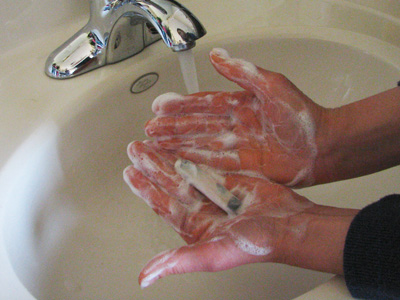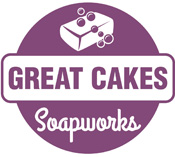Re-formulating My Cold-Process Soap Recipe, Part 1
I’ve been using the same basic recipe for four years now. I added some stearic acid after a review from a highly respected soapmaker felt that my fully cured soap melted away too quickly. It helped some, but I think I could do better. Here are the qualities of my current soap recipe, according to SoapCalc:
Hardness: 47 (recommended range 29-54)
Cleansing: 27 (range 12-22)
Conditioning: 48 (range 44-69)
Bubbly: 31 (range 14-46)
Creamy: 25 (range 16-48)
Iodine: 53 (range 41-70)
INS: 162 (range 136-165)
(You can read more about what these qualities and ranges mean HERE.)
I honestly didn’t even realize that my cleansing number was above the recommended range! I figure it’s time to re-visit my formula at the very least, and I am contemplating whether it’s time to go palm free now as well. The question is whether or not I want to use lard instead. I have no issues with it, but a lot of people do. I realize you can’t please everyone all the time, but if it’s in my ability to make a nice, hard bar of soap with all the conditioning qualities and avoid using palm or lard, I will attempt to do so.
But first, I wanted to experiment with replacing palm with lard and see how the soap performs. This is the recipe I used for Formal Affair:
25% olive
25% coconut
20% lard
15% shea butter
10% castor
5% avocado
(0.8 oz. fragrance per pound of oils)
6.5% superfat
33% lye solution
1 tsp. sodium lactate per pound of oils in the lye solution

Observations:
1. The soap took a long time to trace. I had plenty of time to work with the soap as I was creating it.
2. After 24 hours, the soap was still a bit soft.
3. Discoloration issues: after unmolding the soap, the white parts had turned pinkish tan on the outside. The fragrance I used was non-discoloring, so something in my formula caused a strange reaction. Several days after cutting the soap, the white parts seem slightly grayish, but no more pinkish tan.
4. After just one week, the lather is pretty great! Very foamy, but also very stable.

5. Feels very conditioning on the skin, not drying at all.
Soap Qualities:
Hardness: 41 (range 29-54)
Cleansing: 17 (range 12-22)
Conditioning: 54 (range 44-69)
Bubbly: 21 (range 14-46)
Creamy: 29 (range 16-48)
Iodine: 57 (range 41-70)
INS: 151 (range 136-165)
I’ve lost some hardness, but this formula doesn’t take into account the added sodium lactate which should add some hardness back into the bar. The cleansing number is down within the recommended range. I will have to see how this one performs when it is fully cured. I found that changing the superfat doesn’t seem to change the soap quality numbers, but it sure does change the hardness and feel of the soap in reality. Bottom line: there are factors other than the numbers derived from your soap formula in SoapCalc that will affect your recipe so don’t get too caught up in the those numbers!
My next experiment will be a recipe without palm or lard. Stay tuned!
Page with Comments
Comments are closed.

Thank you, Amy, for sharing this! It’s encouraging to know that as soap makers, whether new or more seasoned, that it’s okay to be adjusting and refining our ingredients and process. Great experiment and beautiful soap!
I don’t use palm oil or lard in my recipes but I do use a whole lot of shea and cocoa butter! They add lots of hardness to the bar and help stabilize lather. In addition with olive oil and/or ricebran oil, coconut oil, and a water discount, my bars end up being super hard, a pale/off-white color, and moisturizing.
Fingers crossed that you fall in love with your new recipe! 🙂
I am in the middle of a recipe reboot as well. I am considering tallow from a local grass fed source to replace my palm oil. We’ll see how it goes:)
Great article, I’ve needed help with recipes. I do use lard, but would like something instead of lard, maybe rice bran, not sure what to use.
Interesting. My personal preference would be to use lard in all my bars – it makes awesome soap in my opinion – but sadly it’s not popular with my customers, so the whole range is palm and lard free these days. I keep meaning to try sodium lactate though – must remember to get me some 🙂
Great article and looking forward to watching your journey. Take that same soap recipe and use tallow instead of lard. I promise you will love it. (or, even increase the tallow). I have found that all but the strictest of vegans don’t have problems with tallow – but they don’t like the thought of pig fat on their body.
Hey Amy! I’m with you! I reworked my main recipe about a year ago since I noticed that my cleansing number was several notches above the recommended range, too. I now use the same 6 oils that you just tried plus palm kernel and sunflower oils. I’m trying to use sunflower oil in place of (or in addition to) olive oil since it is so much more wallet-friendly! But I just love the qualities that lard and palm kernel oils add. I’ve also tried adding local beeswax for a harder bar. It definitely helps, and it’s very good for the skin. After lots of trial and error, I have found that using 1%-1.5% is just about perfect. More than that and the soap is kind of tacky/sticky. Less and it doesn’t make a noticeable difference.
I find it fun to try new formulas, but it also makes me antsy waiting to test and try! Plus, it can get pretty expensive to try lots of different oils and butters. Are you making very small test batches? Thanks for sharing your experiments with us! 🙂 I’d love to read your palm- and lard-free recipe results! And how about the brine soap experimenting? Have you noticed a big difference in hardness with your brine soap? Or does the change in lather negate the hardness factor?
@Katy – I’ve used sunflower oil in my recipe almost since the beginning. I’m beginning to wonder if it’s contributing to the soft soap issue. I also have a customer who is allergic to it, so she can only use my special edition soaps (or the Dead Sea Spa Bar) that don’t have sunflower in them.
I really liked the feel of the brine soaps, but they turned out so unpredictable, and all but one batch are covered with white – looks like a layer of salty film – reminds me of the regular salt bars actually. I think it may be beneficial to stick with around a teaspoon of salt per pound of oils if the goal is a harder bar of soap. I will keep experimenting!
@Anita – I hadn’t considered tallow. I think it’s worth checking into though – thanks!
I’m so new to soapmaking that I shouldn’t even be here probably….but ….does lard or any other of the animal fats go rancid? even though saponified? duh. had to ask.
also, If your soap is way over on the cleanliness……my mother used to say ‘cleanliness is next to Godlinesss”. but really, what is the harm in it? skin removal? skin irritation?
thanks, bonnie
I have been playing with my recipe, as well, but more or less to standardize things. I have tended to create different recipes for different bars, and now I’m using the same recipe for most of my soaps. Sure makes things easier!
@Dana – I completely agree!! My “regular” recipe is nearly the same across the board. I make a few exceptions, but if the recipe is different, it generally has the same oils & butters in it.
Great read & information! I’m new to the soap world & trying to learn all I can- Thanks so much
Hi Amy! Just found your blog, and I love it! Your soaps are beautiful. Im so grateful to find people who share information so graciously. It’s truly appreciated. I’m trying to learn everything I can. Now…if only I could get my soap to not trace so fast I could attempt some techniques. Most of the time, I feel like I’m cramming it into the mold or I end up with soap on a stick. I’m inspired by all you great soapers out there. Thank you so much!
@Amy – Thanks for your comment, and welcome to the wonderful world of soapmaking!! My suggestions would be to use a recipe with plenty of olive oil, mix your oils & lye around 90 degrees, and don’t over blend. It all comes with practice and experience – you’ll get there!
Thanks for sharing Amy!
I too had trials and tribulations while formulating Palm out of my recipe.
I tried both tallow and lard.The ingredient that finally netted me a hard,long lasting recipe was the addition of Kokum butter.Its expensive but with as little as 3% I saw an incredible difference.
Good luck to you and again thanks for sharing this journey!Cheers!